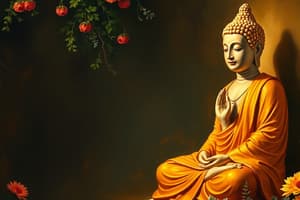Podcast
Questions and Answers
What did Mahayana Buddhists believe about attaining nirvana?
What did Mahayana Buddhists believe about attaining nirvana?
- One must become a monk to aspire to it
- It can only be achieved by monks
- An individual may aspire to nirvana without accepting the homeless state of a monk (correct)
- It is impossible for ordinary working people to attain
Who presides over the Pure Land in Pure Land Buddhism?
Who presides over the Pure Land in Pure Land Buddhism?
Amitabha
Vajrayana or Tibetan Buddhism is also known as the Diamond Path.
Vajrayana or Tibetan Buddhism is also known as the Diamond Path.
True (A)
What does the Triratna in Buddhism consist of?
What does the Triratna in Buddhism consist of?
Define the term 'Karma' in Buddhism.
Define the term 'Karma' in Buddhism.
The first Noble Truth in Buddhism states that all composite things are in a state of ______.
The first Noble Truth in Buddhism states that all composite things are in a state of ______.
In Theravada Buddhism, the central figure is regarded as an incarnation of an eternal Buddha essence.
In Theravada Buddhism, the central figure is regarded as an incarnation of an eternal Buddha essence.
Match the following with their meanings in Buddhism:
Match the following with their meanings in Buddhism:
Flashcards are hidden until you start studying
Study Notes
Doctrines and Creeds
- The Creeds: The Triratna (Buddha, Dharma, Sangha) is central to Buddhist teachings and worship.
- Triratna means "Three Gems" or "Three Jewels", comprising:
- Buddha - the teacher and goal to be attained
- Dharma (Sanskrit) or Dhamma (Pali) - Buddha's teaching and path to be realized
- Sangha - the community of faithful and advanced practitioners of the Dharma
The Four Noble Truths
- The Four Noble Truths are the foundation of Buddha's teaching:
- The Noble Truth of Dukkha (suffering, dissatisfaction, anxiety, etc.)
- The Noble Truth of the Cause of Dukkha (desire for sentient material possessions or intellectual gratification)
- The Noble Truth of the End of Dukkha (freedom from Dukkha is possible by eliminating desire)
- The Noble Truth of the Path leading to the End of Dukkha (the Middle Way, or the Noble Eightfold Path)
The Noble Eightfold Path
- The Noble Eightfold Path is the path to inner peace and tranquility:
- Right knowledge - understanding of the Four Noble Truths
- Right intention - true desire to free from attachment, ignorance, and hatred
- Right speech - abstaining from lying, gossiping, and hurtful talk
- Right conduct - abstaining from hurtful behaviors such as killing, stealing, and sexual misconduct
- Right means of livelihood - making a living through honest means without hurting anyone
- Right effort - abandoning bad while nurturing good qualities
- Right mindfulness - focusing on one's body, thought, and feeling to overcome craving, hatred, and ignorance
- Right concentration - meditating to realize the true meaning of imperfection
Buddhist Worship
- Every act of Buddhist worship begins with the recital of the homage formula:
- "Homage to Him, the Blessed One, the Exalted One, the fully Enlightened One"
- Next comes the recitation of the Three Refuges:
- "I go to the Buddha as my Refuge; I go to the Dharma as my Refuge; I go to the Sangha as my Refuge"
- The Five Precepts are renewed:
- I undertake to abstain from destroying life
- I undertake to abstain from taking things not given
- I undertake to abstain from fornication/adultery or immoral misconduct
- I undertake to abstain from false speech
- I undertake to abstain from intoxicants
Traditions
- There are three main traditions of Buddhism:
- Theravada (Way of the Elders, or Hinayana - Small Vehicle)
- Mahayana (Great Vehicle)
- Vajrayana (Diamond Vehicle) or Tibetan Buddhism
- Each tradition has its own geographical and linguistic characteristics:
- Theravada: Southeast Asia, Sri Lanka, Burma, Thailand, Laos, and Cambodia; Pali Canon
- Mahayana: Eastern Asia, China, Korea, Japan, Vietnam, Tibet, and Mongolia; Sanskrit, Chinese, Japanese, and Tibetan Canons
- Vajrayana: Northern Asia, Tibet, Nepal, Sikkim, Bhutan, and Mongolia; Tibetan Canon
Theravada Buddhism
- Theravada Buddhism is known as the "orthodox" wing of the movement.
- The central figure is the monk, whose ideal is to attain nirvana.
- Monastic discipline and solitary meditation are the rule.
- The daily routine of a monk includes:
- Chanting and meditating
- Begging for food
- Eating breakfast and last meal of the day in a communal dining room
- Afternoon scripture reading and meditation
- Final assembly at sunset
Mahayana Buddhism
- Mahayana Buddhism is a form of Buddhism that is dominant in North, Central, and East Asia.
- It is characterized by a more liberal attitude towards nirvana.
- Mahayana Buddhists believe that an individual may aspire to nirvana without accepting the homeless state of a monk.
- The eternal Buddha essence is believed to be incarnated in Siddharta, who is worshipped as a manifestation of the Buddha.
- Examples of Mahayana Buddhist sects include:
- Pure Land
- Ch'an/Zen
Vajrayana Buddhism
- Vajrayana Buddhism, also known as Tibetan Buddhism, is a form of Buddhism that is dominant in North, Central, and East Asia.
- It is characterized by a growth of Buddhist tantra, influenced by Mahayana and Hinduism.
- The goal of Vajrayana Buddhism is to attain Buddhahood through Tantric practices.
- Tantric practices are more ritualistic and emphasize the visualization of holy beings and the use of mantras or sacred words of power.
- This tradition is dominant in Tibet, Nepal, Sikkim, Bhutan, and Mongolia.
Studying That Suits You
Use AI to generate personalized quizzes and flashcards to suit your learning preferences.




